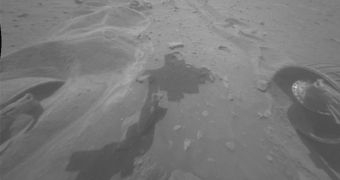On Sol 2092 (Saturday, November 21), the Spirit rover received a new set of commands to drive, as experts were trying to move ahead with the plan of extricating it from its trap. The robot drove into a patch of loose soil called Troy in late April, and the powder-like dust did not allow for it to move since. Only recently have engineers at the NASA Jet Propulsion Laboratory (JPL), which manage the Mars Exploration Rovers (MER) mission, decided to attempt and drive the machine out of its predicament.
The first drive attempt ended prematurely, just seconds after it was initiated. The fault was owed to the fact that the mission planner had set the rover's tilt limits too tight. As soon as the wheels began spinning, the robot exceeded its maximum allowed tilt, and the onboard computer stopped the drive. JPL engineers then spent the next days assessing Spirit's situation, until finally coming to a conclusion about how to proceed next. The initial plans called for the robot to be driven back on its tracks, until it reached harder soil again.
The second drive attempt took place a couple of days later, with revised tilt limits. The machine budged by only an inch, or about 1.2 centimeters, forward and 7 millimeters to the left. The movement also sank the rover into Troy by about 4 millimeters. The second command that was uploaded to the computer, which told Spirit to spin its wheels for a second time, was not executed, because the machine had a limit of moving just 0.4 inches, and that limit was exceeded with the first drive. NASA MER project manager, John Callas, said that the extrication process would take place in small increments and that no one would rush the rover to safety.
The November 21 drive also saw its right-rear wheel stalling during the movements. This is not the same wheel that stalled on Sol 1899 (May 6), the JPL experts say. “The rover had completed about 4 meters (13 feet) of commanded wheel spin before the stall terminated the drive. The center of the rover moved about 4 millimeters (0.2 inch) forward, 3 millimeters (0.1 inch) to the left and about 3 millimeters (0.1 inch) down. The rover suspension stayed within the tighter limits set for the drive, and there was only a fractional change in rover tilt,” a press release on JPL's website announces.
Yesterday, the team uploaded a new set of commands to the robot, this time for diagnostics. The rotor resistance test was run again, alongside a steering test and a small backward rotation of just the right-rear wheel. A short forward commanded motion was also uploaded. Full-scale extrication procedures will only resume tomorrow at the earliest, engineers say.

 14 DAY TRIAL //
14 DAY TRIAL //